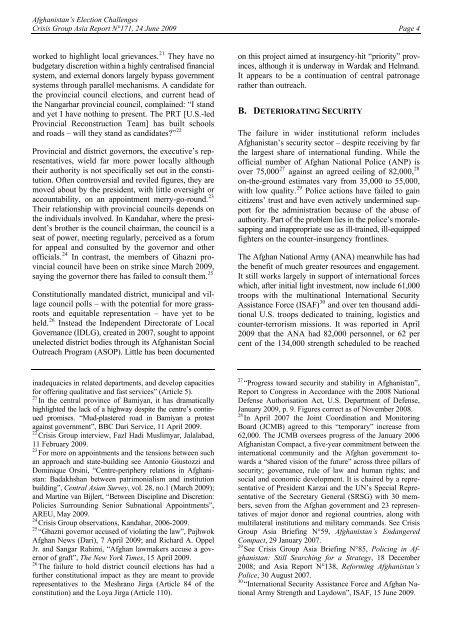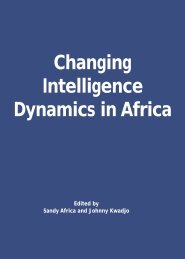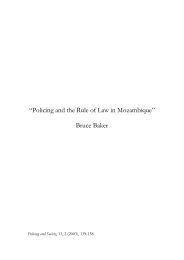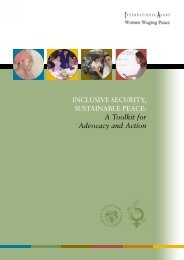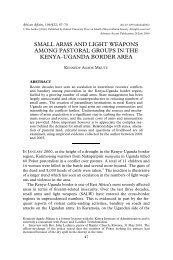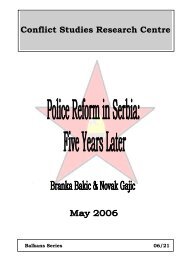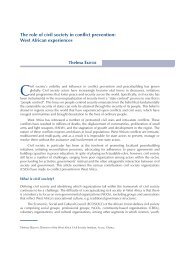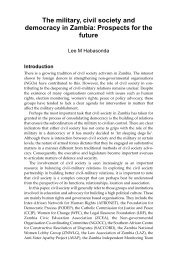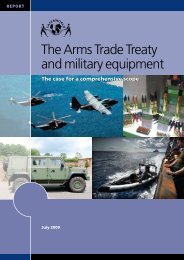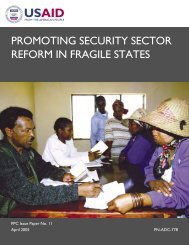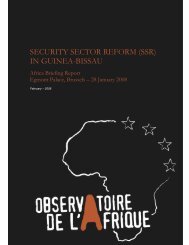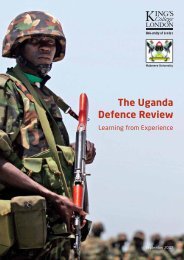AFGHANISTAN'S ELECTION CHALLENGES
AFGHANISTAN'S ELECTION CHALLENGES
AFGHANISTAN'S ELECTION CHALLENGES
You also want an ePaper? Increase the reach of your titles
YUMPU automatically turns print PDFs into web optimized ePapers that Google loves.
Afghanistan’s Election Challenges<br />
Crisis Group Asia Report N°171, 24 June 2009 Page 4<br />
worked to highlight local grievances. 21 They have no<br />
budgetary discretion within a highly centralised financial<br />
system, and external donors largely bypass government<br />
systems through parallel mechanisms. A candidate for<br />
the provincial council elections, and current head of<br />
the Nangarhar provincial council, complained: “I stand<br />
and yet I have nothing to present. The PRT [U.S.-led<br />
Provincial Reconstruction Team] has built schools<br />
and roads – will they stand as candidates?” 22<br />
Provincial and district governors, the executive’s representatives,<br />
wield far more power locally although<br />
their authority is not specifically set out in the constitution.<br />
Often controversial and reviled figures, they are<br />
moved about by the president, with little oversight or<br />
accountability, on an appointment merry-go-round. 23<br />
Their relationship with provincial councils depends on<br />
the individuals involved. In Kandahar, where the president’s<br />
brother is the council chairman, the council is a<br />
seat of power, meeting regularly, perceived as a forum<br />
for appeal and consulted by the governor and other<br />
officials. 24 In contrast, the members of Ghazni provincial<br />
council have been on strike since March 2009,<br />
saying the governor there has failed to consult them. 25<br />
Constitutionally mandated district, municipal and village<br />
council polls – with the potential for more grassroots<br />
and equitable representation – have yet to be<br />
held. 26 Instead the Independent Directorate of Local<br />
Governance (IDLG), created in 2007, sought to appoint<br />
unelected district bodies through its Afghanistan Social<br />
Outreach Program (ASOP). Little has been documented<br />
on this project aimed at insurgency-hit “priority” provinces,<br />
although it is underway in Wardak and Helmand.<br />
It appears to be a continuation of central patronage<br />
rather than outreach.<br />
B. 7DETERIORATING SECURITY<br />
The failure in wider institutional reform includes<br />
Afghanistan’s security sector – despite receiving by far<br />
the largest share of international funding. While the<br />
official number of Afghan National Police (ANP) is<br />
over 75,000 27 against an agreed ceiling of 82,000, 28<br />
on-the-ground estimates vary from 35,000 to 55,000,<br />
with low quality. 29 Police actions have failed to gain<br />
citizens’ trust and have even actively undermined support<br />
for the administration because of the abuse of<br />
authority. Part of the problem lies in the police’s moralesapping<br />
and inappropriate use as ill-trained, ill-equipped<br />
fighters on the counter-insurgency frontlines.<br />
The Afghan National Army (ANA) meanwhile has had<br />
the benefit of much greater resources and engagement.<br />
It still works largely in support of international forces<br />
which, after initial light investment, now include 61,000<br />
troops with the multinational International Security<br />
Assistance Force (ISAF) 30 and over ten thousand additional<br />
U.S. troops dedicated to training, logistics and<br />
counter-terrorism missions. It was reported in April<br />
2009 that the ANA had 82,000 personnel, or 62 per<br />
cent of the 134,000 strength scheduled to be reached<br />
inadequacies in related departments, and develop capacities<br />
for offering qualitative and fast services” (Article 5).<br />
21 In the central province of Bamiyan, it has dramatically<br />
highlighted the lack of a highway despite the centre’s continued<br />
promises. “Mud-plastered road in Bamiyan a protest<br />
against government”, BBC Dari Service, 11 April 2009.<br />
22 Crisis Group interview, Fazl Hadi Muslimyar, Jalalabad,<br />
11 February 2009.<br />
23 For more on appointments and the tensions between such<br />
an approach and state-building see Antonio Giustozzi and<br />
Dominique Orsini, “Centre-periphery relations in Afghanistan:<br />
Badakhshan between patrimonialism and institution<br />
building”, Central Asian Survey, vol. 28, no.1 (March 2009);<br />
and Martine van Bijlert, “Between Discipline and Discretion:<br />
Policies Surrounding Senior Subnational Appointments”,<br />
AREU, May 2009.<br />
24 Crisis Group observations, Kandahar, 2006-2009.<br />
25 “Ghazni governor accused of violating the law”, Pajhwok<br />
Afghan News (Dari), 7 April 2009; and Richard A. Oppel<br />
Jr. and Sangar Rahimi, “Afghan lawmakers accuse a governor<br />
of graft”, The New York Times, 15 April 2009.<br />
26 The failure to hold district council elections has had a<br />
further constitutional impact as they are meant to provide<br />
representatives to the Meshrano Jirga (Article 84 of the<br />
constitution) and the Loya Jirga (Article 110).<br />
27 “Progress toward security and stability in Afghanistan”,<br />
Report to Congress in Accordance with the 2008 National<br />
Defense Authorisation Act, U.S. Department of Defense,<br />
January 2009, p. 9. Figures correct as of November 2008.<br />
28 In April 2007 the Joint Coordination and Monitoring<br />
Board (JCMB) agreed to this “temporary” increase from<br />
62,000. The JCMB oversees progress of the January 2006<br />
Afghanistan Compact, a five-year commitment between the<br />
international community and the Afghan government towards<br />
a “shared vision of the future” across three pillars of<br />
security; governance, rule of law and human rights; and<br />
social and economic development. It is chaired by a representative<br />
of President Karzai and the UN’s Special Representative<br />
of the Secretary General (SRSG) with 30 members,<br />
seven from the Afghan government and 23 representatives<br />
of major donor and regional countries, along with<br />
multilateral institutions and military commands. See Crisis<br />
Group Asia Briefing N°59, Afghanistan’s Endangered<br />
Compact, 29 January 2007.<br />
29 See Crisis Group Asia Briefing N°85, Policing in Afghanistan:<br />
Still Searching for a Strategy, 18 December<br />
2008; and Asia Report N°138, Reforming Afghanistan’s<br />
Police, 30 August 2007.<br />
30 “International Security Assistance Force and Afghan National<br />
Army Strength and Laydown”, ISAF, 15 June 2009.


